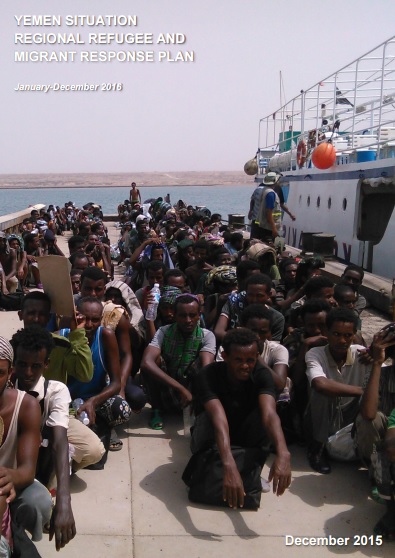A total of USD 94,1 million is requested for the period January - December 2016, including
- USD 39.3 million for Somalia
- USD 29 million for Djibouti
- USD 20 million for Ethiopia
- USD 4,3 million for Sudan
Read the entire Regional Refugee and Migrant Response Plan and access the Latest Updates on the Yeman Situation

The situation in Yemen continuies to deteriorate since fighting intensified in late March 2015. Deepening insecurity and violence have taken a heavy toll on civilian lives and triggered large-scale internal displacement and cross border population movements. Partners now estimate that 21.1 million people – 80 per cent of the population – require some form of humanitarian protection or assistance. As of 14 October 2015, more than 2.3 million people are internally displaced in Yemen, and alongside internal displacement, Yemenis, refugees and migrants were fleeing the country in considerable numbers. As of 1 November around 166,658 arrivals from Yemen have been reported in countries in the Gulf region, as well as in the East and Horn of Africa. Out of the 166,658 who fled Yemen, 75,748 people have arrived in Djibouti, Ethiopia, Somalia and Sudan fleeing the crisis in Yemen.
Most of the Yemenis who fled to the Horn of Africa arrived in Djibouti. As of 1 November around 15,761 Yemenis arrived in Djibouti since the escalation of hostilities in March 2015. It is expected that around 14,000 individuals will flee from Yemen to Djibouti in 2016, bringing the total of Yemenis, Somalis, and other nationals up to 46,530 by the end of 2016. The proximity of Djibouti from Yemen, close cultural, social and linguistic links, and open door policy of the Djiboutian Government, are considered factors for coming to Djibouti. However, the harsh weather conditions, in particular in Obock and Markazi refugee camp, and expensive living conditions in the city, might be prohibitive for some Yemenis. Concerning the gender breakdown, 36 per cent are men above 18 years old, 25 per cent are women and 38 per cent are children. Some men explained they are fleeing for security reasons, avoiding forced recruitment; others lost their income in Yemen, hope to find new opportunity in Djibouti in order to support their family in Yemen.
Today, 2,800 individuals are living in Markazi camp. It is anticipated that the number of camp residents will continue to increase, not only with Yemeni refugees coming from Yemen, but also with Yemeni refugees presently living in the city of Obock, who cannot sustain themselves in the city. The Government of Djibouti recently adopted a new policy to allow Yemenis to reside in urban areas. However, the cost of living in Djibouti city is prohibitive for many Yemenis and as such, they may choose to stay or go back to the Markazi camp in Obock. The needs for both urban and camp refugees are considerable ranging from health, nutrition, shelter, self-reliance, non-food items and protection.
Most of the Somalis who fled Yemen, who were recognized as refugees in Yemen, arrived in Somalia. Indeed, prior to the crisis there were 257,645 recognized refugees under international protection in Yemen. Somali refugees are currently living in precarious conditions either in urban areas or in Kharaz camp, the only refugee camp in Yemen. Somali refugees in Yemen are faced with the difficult decision to return to Somalia, despite the associated protection risks. Since the escalation of the crisis, up to 29,505 individuals (89 per cent Somalis; ten per cent Yemenis, and one per cent other nationalities) fleeing the conflict in Yemen have arrived in Somalia. Reintegration of Somali returnees poses additional challenges as the widespread conflict and political strife have crippled essential infrastructure and more than three quarters of the population in Somalia lack access to healthcare, proper sanitation and safe drinking water.
After the peak of Somali arrivals in Somalia during the first three months of the escalation of the crisis in Yemen, and since August 2015, the rate of arrivals has decreased significantly. It is reported that the situation in Southern Yemen, and Aden in particular contributed to the decision of Somalis to pause before embarking towards the risky and costly journey to Somalia. Indeed, the presence of coalition forces and the arrival of boats carrying humanitarian assistance since the middle of August might have contributed to the ‘wait and see’ situation.
In Ethiopia, the Government recognises Yemenis as prima facie refugees following nationality screening procedures and registration. Those arriving through Jijiga, at the border with Somalia, cannot get assistance from UNHCR until they are registered by the Administration for Refugee and Returnee Affairs (ARRA.) Constant delays add to the hardship of the living conditions. Yemeni refugees can reside in the urban areas, a privilege denied to Somalis. Ethiopia is also facing a food insecurity crisis.
The open door policy and the policy of the Government of Sudan to treat Yemenis as brothers and sisters, would allow Yemenis to work and to move freely, but might deny them assistance granted to refugees of other nationalities.
Both in Sudan and Ethiopia, Yemenis as well as some Somalis came through Djibouti or Somalia, hoping to find better opportunities in these two countries. Onward movement is still a possibility.
 PUBLICATIONS
PUBLICATIONS











